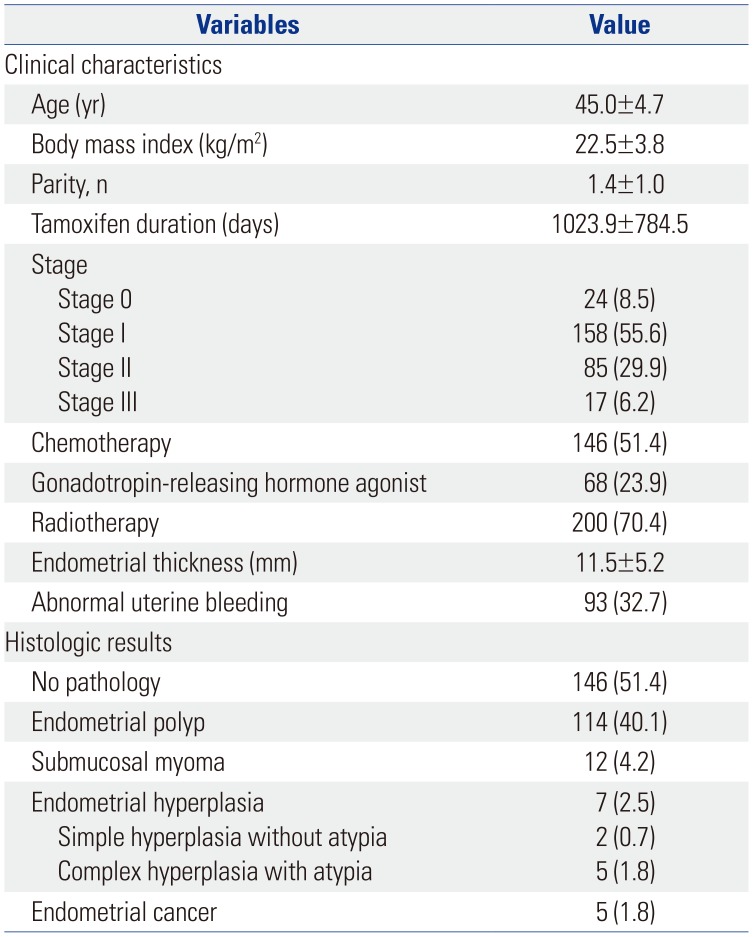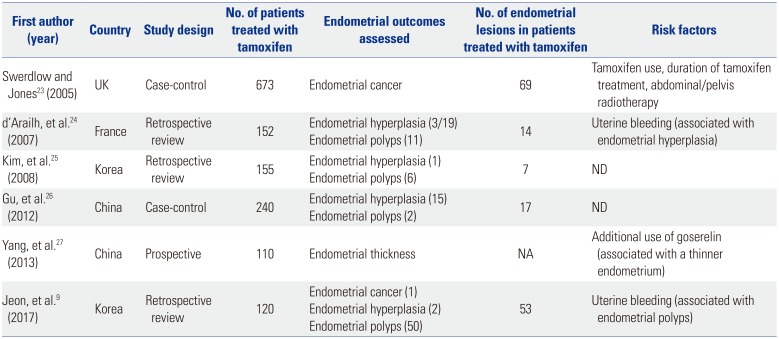1. Kim Z, Min SY, Yoon CS, Jung KW, Ko BS, Kang E, et al. The basic facts of Korean breast cancer in 2012: results from a nationwide survey and breast cancer registry database. J Breast Cancer. 2015; 18:103–111. PMID:
26155285.

2. Park EH, Min SY, Kim Z, Yoon CS, Jung KW, Nam SJ, et al. Basic facts of breast cancer in Korea in 2014: the 10-year overall survival progress. J Breast Cancer. 2017; 20:1–11. PMID:
28382089.

3. Figg WD 2nd, Cook K, Clarke R. Aromatase inhibitor plus ovarian suppression as adjuvant therapy in premenopausal women with breast cancer. Cancer Biol Ther. 2014; 15:1586–1587. PMID:
25535893.

4. LE Donne M, Alibrandi A, Ciancimino L, Azzerboni A, Chiofalo B, Triolo O. Endometrial pathology in breast cancer patients: effect of different treatments on ultrasonographic, hysteroscopic and histological findings. Oncol Lett. 2013; 5:1305–1310. PMID:
23599784.

5. Davies C, Pan H, Godwin J, Gray R, Arriagada R, Raina V, et al. Long-term effects of continuing adjuvant tamoxifen to 10 years versus stopping at 5 years after diagnosis of oestrogen receptor-positive breast cancer: ATLAS, a randomised trial. Lancet. 2013; 381:805–816. PMID:
23219286.
6. Goss PE. Preventing relapse beyond 5 years: the MA.17 extended adjuvant trial. Semin Oncol. 2006; 33(2 Suppl 7):S8–S12.

7. Sismondi P, Biglia N, Volpi E, Giai M, de Grandis T. Tamoxifen and endometrial cancer. Ann N Y Acad Sci. 1994; 734:310–321. PMID:
7978932.

8. Cohen I, Altaras MM, Shapira J, Tepper R, Rosen DJ, Cordoba M, et al. Time-dependent effect of tamoxifen therapy on endometrial pathology in asymptomatic postmenopausal breast cancer patients. Int J Gynecol Pathol. 1996; 15:152–157. PMID:
8786205.

9. Jeon SJ, Lee JI, Lee M, Kim HS, Kim JW, Park NH, et al. Endometrial polyp surveillance in premenopausal breast cancer patients using tamoxifen. Obstet Gynecol Sci. 2017; 60:26–31. PMID:
28217668.

10. Cheng WF, Lin HH, Torng PL, Huang SC. Comparison of endometrial changes among symptomatic tamoxifen-treated and nontreated premenopausal and postmenopausal breast cancer patients. Gynecol Oncol. 1997; 66:233–237. PMID:
9264568.

11. Saccardi C, Gizzo S, Patrelli TS, Ancona E, Anis O, Di Gangi S, et al. Endometrial surveillance in tamoxifen users: role, timing and accuracy of hysteroscopic investigation: observational longitudinal cohort study. Endocr Relat Cancer. 2013; 20:455–462. PMID:
23629476.

12. Berlière M, Charles A, Galant C, Donnez J. Uterine side effects of tamoxifen: a need for systematic pretreatment screening. Obstet Gynecol. 1998; 91:40–44. PMID:
9464718.

13. Fisher B, Costantino JP, Redmond CK, Fisher ER, Wickerham DL, Cronin WM. Endometrial cancer in tamoxifen-treated breast cancer patients: findings from the National Surgical Adjuvant Breast and Bowel Project (NSABP) B-14. J Natl Cancer Inst. 1994; 86:527–537. PMID:
8133536.
14. Braithwaite RS, Chlebowski RT, Lau J, George S, Hess R, Col NF. Meta-analysis of vascular and neoplastic events associated with tamoxifen. J Gen Intern Med. 2003; 18:937–947. PMID:
14687281.

15. Fornander T, Rutqvist LE, Cedermark B, Glas U, Mattsson A, Silfverswärd C, et al. Adjuvant tamoxifen in early breast cancer: occurrence of new primary cancers. Lancet. 1989; 1:117–120. PMID:
2563046.

16. Cohen I, Bernheim J, Azaria R, Tepper R, Sharony R, Beyth Y. Malignant endometrial polyps in postmenopausal breast cancer tamoxifen-treated patients. Gynecol Oncol. 1999; 75:136–141. PMID:
10502440.

17. Iqbal J, Ginsburg OM, Wijeratne TD, Howell A, Evans G, Sestak I, et al. Endometrial cancer and venous thromboembolism in women under age 50 who take tamoxifen for prevention of breast cancer: a systematic review. Cancer Treat Rev. 2012; 38:318–328. PMID:
21775065.

18. Garuti G, Cellani F, Centinaio G, Sita G, Nalli G, Luerti M. Baseline endometrial assessment before tamoxifen for breast cancer in asymptomatic menopausal women. Gynecol Oncol. 2005; 98:63–67. PMID:
15894357.

19. Pennant ME, Mehta R, Moody P, Hackett G, Prentice A, Sharp SJ, et al. Premenopausal abnormal uterine bleeding and risk of endometrial cancer. BJOG. 2017; 124:404–411. PMID:
27766759.

20. Bergman L, Beelen ML, Gallee MP, Hollema H, Benraadt J, van Leeuwen FE. Risk and prognosis of endometrial cancer after tamoxifen for breast cancer. Lancet. 2000; 356:881–887. PMID:
11036892.

21. Gerber B, Krause A, Müller H, Reimer T, Külz T, Makovitzky J, et al. Effects of adjuvant tamoxifen on the endometrium in postmenopausal women with breast cancer: a prospective long-term study using transvaginal ultrasound. J Clin Oncol. 2000; 18:3464–3470. PMID:
11032586.

22. Fung MF, Reid A, Faught W, Le T, Chenier C, Verma S, et al. Prospective longitudinal study of ultrasound screening for endometrial abnormalities in women with breast cancer receiving tamoxifen. Gynecol Oncol. 2003; 91:154–159. PMID:
14529676.

23. Swerdlow AJ, Jones ME. British Tamoxifen Second Cancer Study Group. Tamoxifen treatment for breast cancer and risk of endometrial cancer: a case-control study. J Natl Cancer Inst. 2005; 97:375–384. PMID:
15741574.

24. d'Arailh AS, Michy T, Pioud R, Dravet F, Classe JM. [Uterine abnormalities in non menopausal women who received tamoxifen for breast cancer adjuvant therapy]. Gynecol Obstet Fertil. 2007; 35:1215–1219. PMID:
18035581.
25. Kim HS, Jeon YT, Kim YB. The effect of adjuvant hormonal therapy on the endometrium and ovary of breast cancer patients. J Gynecol Oncol. 2008; 19:256–260. PMID:
19471651.

26. Gu R, Jia W, Zeng Y, Rao N, Hu Y, Li S, et al. A comparison of survival outcomes and side effects of toremifene or tamoxifen therapy in premenopausal estrogen and progesterone receptor positive breast cancer patients: a retrospective cohort study. BMC Cancer. 2012; 12:161. PMID:
22548922.

27. Yang H, Zong X, Yu Y, Shao G, Zhang L, Qian C, et al. Combined effects of goserelin and tamoxifen on estradiol level, breast density, and endometrial thickness in premenopausal and perimenopausal women with early-stage hormone receptor-positive breast cancer: a randomised controlled clinical trial. Br J Cancer. 2013; 109:582–588. PMID:
23860520.









 PDF
PDF ePub
ePub Citation
Citation Print
Print



 XML Download
XML Download